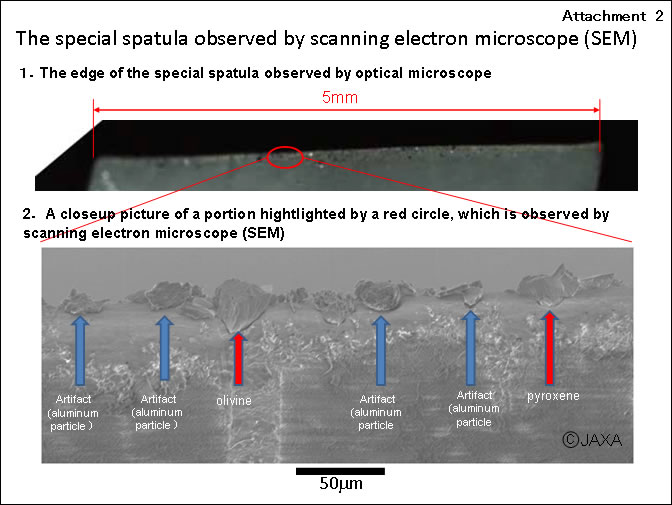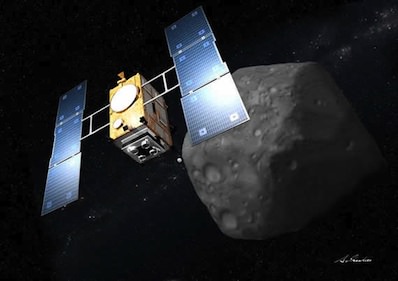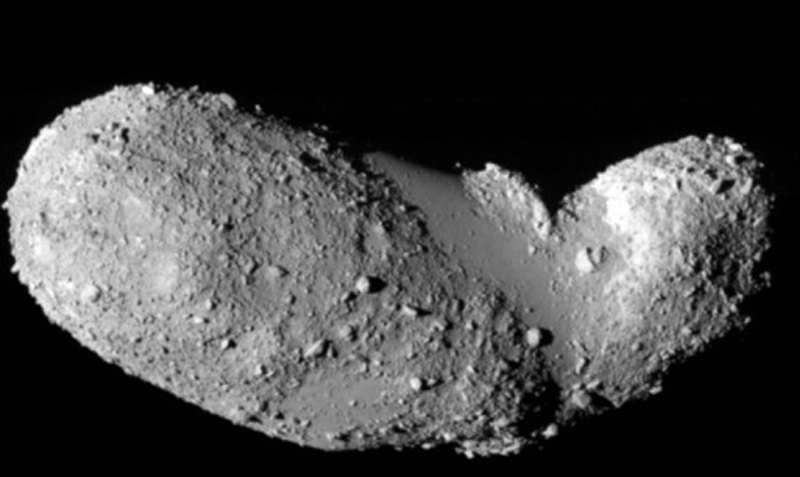Dust Scooped From Asteroid Confirms Source of Earth-Bound Meteorites
American Association for the Advancement of Science (AAAS) | 2011 Aug 25
Researchers got their first up-close look at dust from a small, stony asteroid after the Hayabusa spacecraft scooped up the dust from the asteroid’s surface and brought it back to Earth. Analysis of the dust particles, detailed in the 26 August issue of Science, confirms a long-standing suspicion: Most common meteorites found here on Earth, known as ordinary chondrites, are born from these stony, or S-type, asteroids.
Since chondrites are among the most primitive objects in the solar system, the discovery also means that these asteroids have been recording a long and rich history of early solar system events.
“Science is very excited and pleased to be presenting these important scientific analyses,” said Brooks Hanson, the journal’s deputy editor for the physical sciences. “The first samples that researchers collected beyond Earth were from the moon, and the first analyses of those samples were also published in Science. Those samples, along with the more recent sampling of a comet and the solar wind, have changed our understanding of the solar system and Earth. They are still yielding important results.”
The Hayabusa spacecraft was launched by the Japan Aerospace Exploration Agency (JAXA) in 2003 to sample the surface of the near-Earth asteroid known as 25143 Itokawa. The unmanned vessel reached its destination a little more than two years later—and in November 2005, it made two separate touchdowns on the surface of Itokawa.
Although its primary sampler malfunctioned, the spacecraft was able to strike the asteroid’s surface with an elastic sampling horn and catch the small amount of loose surface material, or regolith, that was kicked up. After reentering Earth’s atmosphere and landing in South Australia in June 2010, Hayabusa’s delicate samples were analyzed extensively by various teams of researchers.
“These Hayabusa samples are the first samples of an asteroid,” Hanson said. “Not only do they provide important information about the history of the asteroid Itokawa, but by providing the needed ground truth that is only possible through direct sampling, they also help make other important samples—like meteorite collections and the lunar samples—even more useful.”
The asteroid sampled by Hayabusa is a rocky, S-type asteroid with the appearance of a rubble pile. Based on observations from the ground, researchers believed that similar S-type asteroids, generally located in our solar system’s inner and middle asteroid belt, are responsible for most of the small meteorites that regularly strike Earth.
But the visible spectra—the unique fingerprint of reflected light—of these asteroids have never precisely matched those of ordinary chondrites, leaving researchers suspicious of their actual affiliation. The only way to confirm a direct relationship between meteorites and the S-type asteroids was to sample the regolith directly from an asteroid’s surface.
Tomoki Nakamura from Tohoku University in Sendai, Japan and colleagues in Japan and the United States were among the first to analyze the regolith brought back by Hayabusa. The team of researchers used a combination of powerful electron microscopes and X-ray diffraction techniques to study the mineral chemistry of Itokawa’s dust particles.
“Our study demonstrates that the rocky particles recovered from the S-type asteroid are identical to ordinary chondrites, which proves that asteroids are indeed very primitive solar system bodies,” said Nakamura.
The researchers also noticed that Itokawa’s regolith has gone through significant heating and impact shocks. Based on its size, they conclude that the asteroid is actually made up of small fragments of a much bigger asteroid.
“The particles recovered from the asteroid have experienced long-term heating at about 800 degrees Celsius,” said Nakamura. “But to reach 800 degrees, an asteroid would need to be about 12.4 miles (20 kilometers) in diameter. The current size of Itokawa is much smaller than that, so it must have first formed as a larger body, then been broken by an impact event and reassembled in its current form.”
Separate teams of researchers, including Mitsuru Ebihara from Tokyo Metropolitan University and colleagues from the United States and Australia, cut open the tiny regolith grains returned by Hayabusa to get a look at the minerals inside them. Their composition shows that the dust grains have preserved a record of primitive elements from the early solar system. Those mineral compositions now can be compared to tens of thousands of meteorites that have fallen to Earth, and correlated to the visible spectra of other asteroids in space.
Akira Tsuchiyama from Osaka University in Toyonaka, Japan and colleagues from around the world also analyzed the three-dimensional structures of the dust particles. Since dust from the surface of the moon is the only other type of extraterrestrial regolith that researchers have been able to sample directly (from the Apollo and Luna missions), the researchers closely compared the two types.
“The cool thing about this Itokawa analysis is the tremendous amount of data we can get from such a small sample,” said Michael Zolensky of the NASA Johnson Space Center in Houston, Texas, a co-author of the research. “When researchers analyzed regolith from the moon, they needed kilogram-sized samples. But for the past 40 years, experts have been developing technologies to analyze extremely small samples. Now, we’ve gained all this information about Itokawa with only a few nanograms of dust from the asteroid.”
According to the researchers, Itokawa’s regolith has been shaped by erosion and surface impacts on the asteroid. Lunar regolith, which has spent more time exposed to solar winds and space weathering, has been more chemically altered.
Takaaki Noguchi from Ibaraki University in Mito, Japan, and colleagues cite this chemical difference between the lunar dust and the Itokawa samples as one of the reasons astronomers have never been able to definitively tie ordinary chondrites to S-type asteroids in the past.
“Space weathering is the interaction between the surface of airless bodies, like asteroids and the moon, and the energetic particles in space,” said Noguchi. “When these energetic particles—like solar wind, plasma ejected from the Sun, and fast-traveling micrometeoroids—strike an object, pieces of them condense on the surface of that object. In the vacuum of space, such deposits can create small iron particles that greatly affect the visible spectra of these celestial bodies when they are viewed from Earth.”
Instead of using lunar samples to estimate the space weathering on an asteroid, researchers now can turn to the asteroid regolith for direct insight into such processes.
Two more international studies led by Keisuke Nagao from the University of Tokyo and Hisayoshi Yurimoto from Hokkaido University in Sapporo, Japan, have determined how long the regolith material has been on the surface of Itokawa and have established a direct link between the oxygen isotopes in ordinary chondrites and their parent, S-type asteroids.
According to the researchers, the dust from Itokawa has been on the surface of the asteroid for less than eight million years. They suggest that regolith material from such small asteroids might escape easily into space to become meteorites, traveling toward Earth.
“This dust from the surface of the Itokawa asteroid will become a sort of Rosetta Stone for astronomers to use,” according to Zolensky. “Now that we understand the bulk mineral and chemical composition of the Hayabusa sample, we can compare it to meteorites that have struck the Earth and try to determine which asteroids the chondrites came from.”
Asteroid visit finds familiar dust
Nature News | Richard A. Lovett | 2011 Aug 25
Samples from 25143 Itokawa show it has similar make-up to most meteorites on Earth.
Dust grains scooped from a 500-metre-long asteroid have been linked to the most common type of meteorites found on Earth, report a team of Japanese scientists in a suite of papers in Science today.
The samples were collected from the asteroid's surface by Japan's Hayabusa spacecraft after a seven-year journey from Earth. The near-Earth asteroid, measuring 200 metres across, is known as 25143 Itokawa, and this is the first time that samples have been retrieved from the surface of any extraterrestrial body other than the Moon.
This particular asteroid was chosen because scientists suspected from spectroscopic similarities that asteroids of Itokawa's type — known as S-type because of their siliceous (stony) content — were the source of the vast majority of meteorites that end up on Earth, known as ordinary chondrites.
Even though S-type asteroids represent only a fraction of all the different types within the asteroid belt located between Mars and Jupiter, the theory made sense. S-types are commonly found on the inner fringes of the belt, so scientists assumed that any chips blown off them would often hit Earth. However, no one had been able to verify the assumption because asteroids had previously only been studied by telescopes and passing spacecraft.
"Now we have a direct link, not conjecture," says Don Brownlee, an astronomer at the University of Washington in Seattle, who was not part of the study team.
Asteroid timeline
The scientists were also able to measure the effects of 'space weathering' — the process by which the surfaces of asteroids are altered by cosmic rays, the solar wind and micrometeoroids. These changes, along with the amounts of helium, neon and argon in the rock, can be used to determine how long an asteroid's surface has been exposed to space.
The result was surprising: according to a team led by Keisuke Nagao of the University of Tokyo, the dust collected from Itokawa had been exposed to this radiation for no more than eight million years. This relatively short period of space weathering indicates that the asteroid is eroding at the rate of several tens of centimetres every million years, thus exposing a fresh surface to be weathered.
"This is a quite unexpected result," says Alexander Krot, a meteorite expert at the University of Hawaii at Manoa, Honolulu. "This asteroid's lifetime is quite short. In several hundred million years, it will just disappear."
Another important find is that early in their history the minerals in the dust grains collected from Itokawa have been heated enough to have metamorphosed. A team led by Tomoki Nakamura from Tohoku University in Sendai, Japan, reports that particles recovered from the asteroid seem to have experienced long-term heating at about 800 °C.
Heat would have been supplied within the asteroid by the radioactive decay of aluminium-26, a short-lived isotope that was a primary source of heating in the first few million years of the Solar System. But a small asteroid such as Itokawa wouldn't have contained enough aluminium-26 to generate sufficient heat to metamorphose rock. "To reach 800 °C, an asteroid would need to be about 20 kilometres in diameter," Nakamura says.
This suggests that the present asteroid is a fragment of a larger body. "It must have been broken by an impact, and reassembled in its current form," he says.
Puzzling processes
But not all of the grains brought back to Earth show the same degree of heating. "This is a complicated body," Brownlee says, "some of which is more processed [by heating] and some less processed."
At the same time, notes Humberto Campins, a planetary scientist at the University of Central Florida, Orlando, the fact that the spacecraft was able to collect small grains from the surface indicates that they are being continually produced by some process, possibly seismic or from micrometeorite impacts. "That's also very interesting," he says, adding that is it good news for future asteroid-sampling missions, such as NASA's OSIRIS-REx, for which he is a member of the science team.
The mission's greatest success, however, could be seen as a technological one. Despite a litany of woes — ranging from Hayabusa being hit by a near-crippling solar flare shortly after launch to uncertainties about whether the sample container had properly sealed before the spacecraft lifted off for its return to Earth — the mission certainly produced results.
But the findings still present a puzzle. Although Itokawa has been shown to be a source of ordinary chondrites, the asteroid's mineralogical make-up isn't of the same type as that found in the most common chondrite meteorites, says Campins.
Most meteorites, he says, are H or L chondrites — indicating 'high' or 'low' iron content. Itokawa is LL, meaning it has a very low iron content — and LL chondrites are the least abundant of all the ordinary chondrites found on Earth. "The Itokawa mission confirms a bunch of things, and also confirms a puzzle," Campins says.
Itokawa Dust Particles: A Direct Link Between S-Type Asteroids and Ordinary Chondrites - T. Nakamura
et al
Oxygen Isotopic Compositions of Asteroidal Materials Returned from Itokawa by the Hayabusa Mission - H. Yurimoto
et al
Neutron Activation Analysis of a Particle Returned from Asteroid Itokawa - M. Ebihara
et al
Incipient Space Weathering Observed on the Surface of Itokawa Dust Particles - T. Noguchi
et al
Three-Dimensional Structure of Hayabusa Samples: Origin and Evolution of Itokawa Regolith - A. Tsuchiyama
et al
Irradiation History of Itokawa Regolith Material Deduced from Noble Gases in the Hayabusa Samples - K.Nagao
et al
Japanese Asteroid Mission A Success
University of Central Florida | 2011 Aug 25
Extraterrestrial dust reveals asteroid's past and future
New Scientist | Maggie McKee | 2011 Aug 25
Asteroid sample nails meteorite source
Science News | Nadia Drake | 2011 Aug 25
Huge Asteroid Impact Formed "Rubble Pile" Space Rock
National Geographic | Ker Than | 2011 Aug 25
Mystery Solved: Earth's Meteorites Came From Stony Asteroids
Space.com | Charles Q. Choi | 2011 Aug 25














